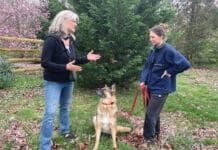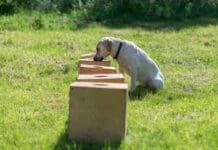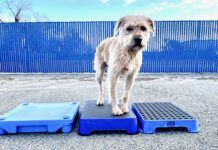We’ve all heard the saying, “a tired dog is a good dog,” but more isn’t always better when it comes to physical activity. If you’re trying to use exercise to help your dog relax the rest of the day, walking smarter, not farther, can help you meet your goal. It also creates wonderful opportunities for strengthening dog-owner relationships.

There’s one question I’d like you to consider every time you snap on your dog’s leash and head out for a walk: What kind of walk are you taking?
I have various goals for my dog walks at different times. Sometimes my walk is more about meeting an exercise goal for myself, or an opportunity to socialize with a friend, and I bring my dog along so he can benefit from the exercise as well. For those walks, my focus is mostly self-centered, as I will myself to push farther up an inclined trail or enthusiastically chat with a friend.
While walking, I might use a no-pull harness to manage my dog’s leash pulling (since I know I’ll likely be too distracted to train), and my dog and I are largely in our own separate worlds as we walk. Of course, I still keep an eye on the environment, as it’s my responsibility to ensure our safety. Fortunately, my dog doesn’t have any major reactivity issues I need to be alert for and prepared to suddenly train through or manage. I might ask for a sit here and there, but largely, he and I are walking together, yet each doing our own thing.
Most of the time, though, my walks are far more interactive. I don’t want to take my dog for a walk; I want to enjoy a walk with my dog. Dogs as a species were bred to work cooperatively with humans, and training time is a wonderful way to honor that evolutionary history, while helping to meet your dog’s need for human interaction. Time spent training together can strengthen the connection and bond you share with your dog. Training while on a walk allows you to practice a variety of known skills, and working away from home helps your dog learn to deal with real-world distractions.
“It takes energy to solve puzzles,” says Amy Cook, PhD, of Full Circle Dog Training in Oakland, California. “Training on walks means our dogs have to concentrate more and work to filter out distractions, and that’s costly in energy.” In other words, thinking is hard work. The more your dog thinks, the more energy he uses.
Even a simple walk around the block is full of plenty of opportunities to have fun while asking your dog to think through some simple training challenges. When I head out for a training walk, I still give my dog some “personal time” where he’s allowed to sniff and explore on a loose leash. That’s important, too. Roughly one-third of a dog’s brain is dedicated to olfaction; it feels unfair to deny them a good sniff-fest!
When you’re ready, there are lots of ways to throw some training into the mix, while keeping the walk light-hearted and enjoyable for the animals on both ends of the leash.
Make the fundamentals fun! Incorporate basic skills practice into the walk:
– Practice a quick response to your dog’s name. When he turns and looks at you, sometimes mark and reward on the fly as you keep moving, and sometimes mark and back up a few steps, encouraging your dog toward you, then deliver several small treats (one after another, rather than a handful at once), paired with praise and petting.
– Play “Red Light, Green Light!” This children’s game is a great way to work on sits and downs. At random intervals during your walk, ask your dog to “sit” or “down.” This can be adapted easily to your dog’s level of training, from using a lure to help get the behavior, to challenging your dog to be ready to respond to verbal-only cues when he least expects it.
Vary the challenge by sometimes specifying where you’d like your dog to sit or down. For example, if he likes to swing out in front of you, work on keeping him parallel to you, in heel position. Sometimes vary your pace just before you ask for a sit or down. Can your dog contain his excitement and pull off a quick sit or down after you excitedly run forward 10 steps? Try changing sides. If he’s used to working on your left, can he walk on your right (“Green light!”) and sit or lie down (“Red light!”) on that same side, without trying to drift back to the familiar left side?
These little changes might sound easy, but remember that dogs can be slow to generalize a behavior. Even subtle changes can feel like a totally different behavior to your dog at first.
– Recall Challenges. People often assume they need an extra-long leash in order to practice what looks like a real-life recall, but all of my recall training is done on a regular six-foot leash. The hardest part of coming when called is not the distance the dog travels back to the handler. The hardest part of coming when called is choosing to leave an exciting distraction in favor of returning to the handler – whether he’s six feet or 60 feet away.
After I’ve spent time teaching my dog to associate his recall word with an amazing party of treats, praise, petting, and play, and have spent a fair amount of time practicing at home (where it’s easiest to do), I start challenging my dog to come away from distractions while exploring on a walk.
The first few times I introduce this challenge, I warm up the recall behavior with a few practice sessions that closely match how I trained the behavior at home. Then I walk my dog up to what I think will be a relatively easy distraction, for example, the base of a tree (as opposed to a tree full of dog-mocking squirrels). While he’s sniffing, I quietly move behind him, backing up to the end of the leash. Once in position, I call my dog using his name (which I teach to mean, “Quick! Pay attention!”) and his recall word.
If he turns toward me, I immediately mark the correct choice (with the “Click!” of a clicker or a verbal marker, such as the word “Yes!”) and cheer him on as I run away, encouraging him to chase me for several steps. Then we stop and enjoy a full 30 to 60 seconds of praise, petting, and several rapid-fire treats delivered one at a time.
If the dog doesn’t immediately turn away from the distraction when I call him, I’ll quickly step in and make a funny noise to get his attention and/or lightly and playfully goose him. The instant I have his attention, I excitedly repeat the recall word as I run off and invite him to chase me. This sequence ends in an even bigger reinforcement routine than if he’d done it right all on his own.
This often puzzles people who think, “If I had to help him, why should he be rewarded?” The reason? If you had to help him, your dog is telling you he doesn’t believe you’re willing to be as much fun as he was having with the distraction. In other words, he didn’t think it was worth it to leave the distraction. Over time, the magnificence of your reinforcement is what teaches your dog that coming when called is definitely worth it. Be sure to pay well!

Note: If you find your dog frequently needs help leaving distractions, choose less-exciting distractions and revisit your early recall training in a distraction-free environment.
I try to fit at least five recall distraction trials into every walk. Walks are full of myriad opportunities for practice: Call your dog away from a prolonged sniff of a tree. Call your dog away from staring at other dogs across the park. Call your dog away from the neighbor after a quick “Hello.” You can even call your dog during the walk itself. If you’re cruising along and your dog’s focus is fully forward, surprise him with a quick recall trial. Be creative! In my opinion, learning to turn away from distractions is the single most important skill needed for developing a reliable recall – and a reliable recall might save your dog’s life some day!
– Interpersonal play. I’m a big fan of interacting with a dog through play. I love teaching tug games because they give dogs a great outlet for normal dog behaviors, while providing opportunities to practice impulse control and relinquishing a prized object. I often walk my dog with a favorite tug toy in my back pocket. He never knows when I might suddenly invite him to play a quick game of tug during a walk. Sometimes we stop walking and tug for 30 seconds, and sometimes I invite him to tug while we walk.
Many dogs enjoy playing tug games with their owners at home, but are reluctant to engage in the game away from home. For some dogs, it’s a matter of habit; they’re used to playing tug at home, not while on a walk. Some dogs are so interested in the environment that a game of tug suddenly seems less exciting. And some dogs worry when away from home, and lack the confidence needed to “let their hair down” and play.
Each case provides its own unique training challenge, but it’s well worth the effort to systematically work through the issue. Adding quick games of tug while on a walk is a great way to reward polite leash walking and correct responses to cued behaviors, while helping your dog burn additional energy.
If your dog is confident and able to focus away from home, but doesn’t enjoy tug games (or you prefer not to play tug), experiment to discover what type of interpersonal play is fun for your dog. Challenge yourself to keep your dog’s interest without using food or toys. Turn sideways and crouch down in a playful stalking gesture. Tap into his opposition reflex by gently pushing him away and encouraging him to move back into your space. Send him through your legs as you run the opposite direction and encourage him to turn and chase you. (Okay, that last one is hard to do on-leash during a walk, but it’s still fun!)
Play is a key component of building a solid relationship. For some dogs, you’ll need to build this skill at home before taking it into the world on a walk. As you practice, watch your dog’s body language, and be careful not to overwhelm him with your enthusiasm. While it might sound easy, interspecies play is a complex topic in dog training. To learn more, check out Dog Sports Skills Book 3: Play! by Denise Fenzi and Deb Jones.
– Use the environment to keep training interesting. Random objects in the environment are great for helping dogs learn to generalize behaviors while adding novelty to daily walks. Invite your dog to hop up and sit on a bus bench (for you city slickers) or a tree stump (for the rural dwellers). Practice any tricks that can be done safely on an elevated surface. Ask your dog to put his front feet on a raised object such as a drinking fountain, the bottom of a slide in the park, or the base of a tree. Hop up and walk along a raised barrier wall. Walk underneath an A-frame-style advertising sign.
Be creative as you look for new, safe ways to challenge your dog. Using objects in the environment is a great way to engage your dog’s body and brain, and is even part of a fun new sport called Dog Parkour. (For more information, check out the International Dog Parkour Association, dogparkour.org.)
– Change your route to change the scenery. I live in a densely populated, busy Los Angeles suburb. When I walk out my door, I have access to several different walking routes. I make a point to not take the same route twice in a row. The change of scenery keeps things interesting for everybody. A familiar walk is always better than no walk, but watch your dog while walking in a new environment; you’ll likely find his senses are in overdrive as he takes in the novel sights, sounds, and smells. Processing all the new stimuli is tiring work!
If your immediate neighborhood options are limited, consider jumping in the car and driving to the nearest shopping center. Shopping centers offer a wealth of novel stimuli to dazzle your dog’s senses, as well as urban distractions around which to train.
With a little forethought and creativity, you’ll soon find that training walks set you on a path not just toward better cardiovascular health, but a stronger, more interactive relationship with your dog!






Great ideas for my 8 month old cocker. I think she will get more interested in birds and squirrels as the Spring comes so I need to do things with her on my walks around Corsham in Wiltshire.
Thanks
Steve